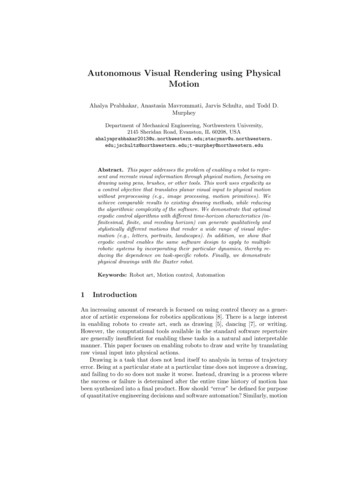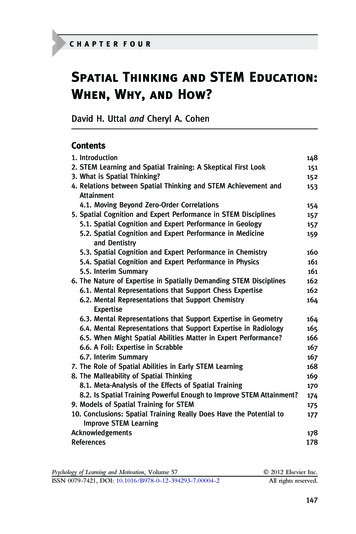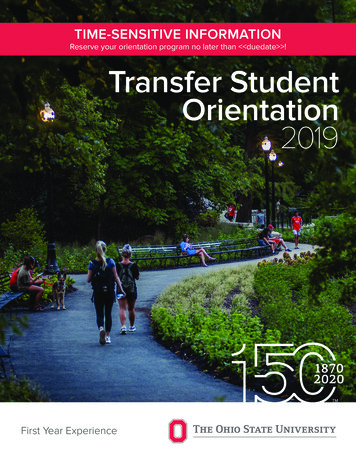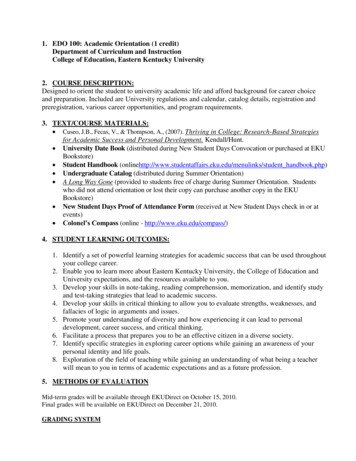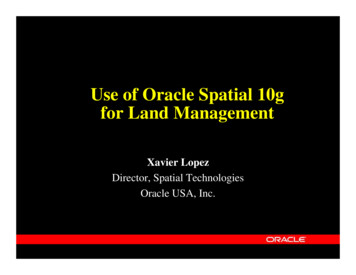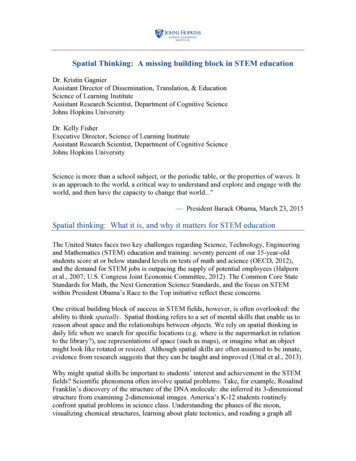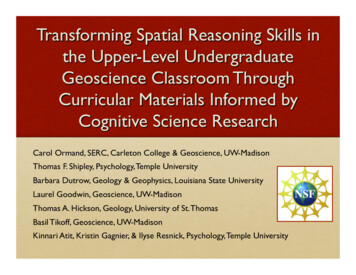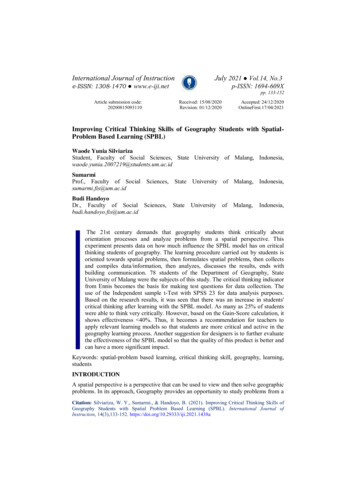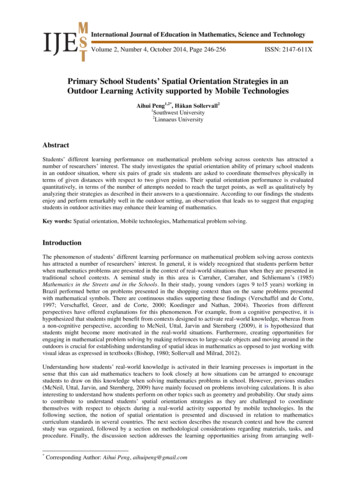
Transcription
International Journal of Education in Mathematics, Science and TechnologyVolume 2, Number 4, October 2014, Page 246-256ISSN: 2147-611XPrimary School Students’ Spatial Orientation Strategies in anOutdoor Learning Activity supported by Mobile TechnologiesAihui Peng1,2*, Håkan Sollervall21Southwest University2Linnaeus UniversityAbstractStudents’ different learning performance on mathematical problem solving across contexts has attracted anumber of researchers’ interest. The study investigates the spatial orientation ability of primary school studentsin an outdoor situation, where six pairs of grade six students are asked to coordinate themselves physically interms of given distances with respect to two given points. Their spatial orientation performance is evaluatedquantitatively, in terms of the number of attempts needed to reach the target points, as well as qualitatively byanalyzing their strategies as described in their answers to a questionnaire. According to our findings the studentsenjoy and perform remarkably well in the outdoor setting, an observation that leads us to suggest that engagingstudents in outdoor activities may enhance their learning of mathematics.Key words: Spatial orientation, Mobile technologies, Mathematical problem solving.IntroductionThe phenomenon of students’ different learning performance on mathematical problem solving across contextshas attracted a number of researchers’ interest. In general, it is widely recognized that students perform betterwhen mathematics problems are presented in the context of real-world situations than when they are presented intraditional school contexts. A seminal study in this area is Carraher, Carraher, and Schliemann’s (1985)Mathematics in the Streets and in the Schools. In their study, young vendors (ages 9 to15 years) working inBrazil performed better on problems presented in the shopping context than on the same problems presentedwith mathematical symbols. There are continuous studies supporting these findings (Verschaffel and de Corte,1997; Verschaffel, Greer, and de Corte, 2000; Koedinger and Nathan, 2004). Theories from differentperspectives have offered explanations for this phenomenon. For example, from a cognitive perspective, it ishypothesized that students might benefit from contexts designed to activate real-world knowledge, whereas froma non-cognitive perspective, according to McNeil, Uttal, Jarvin and Sternberg (2009), it is hypothesized thatstudents might become more motivated in the real-world situations. Furthermore, creating opportunities forengaging in mathematical problem solving by making references to large-scale objects and moving around in theoutdoors is crucial for establishing understanding of spatial ideas in mathematics as opposed to just working withvisual ideas as expressed in textbooks (Bishop, 1980; Sollervall and Milrad, 2012).Understanding how students’ real-world knowledge is activated in their learning processes is important in thesense that this can aid mathematics teachers to look closely at how situations can be arranged to encouragestudents to draw on this knowledge when solving mathematics problems in school. However, previous studies(McNeil, Uttal, Jarvin, and Sternberg, 2009) have mainly focused on problems involving calculations. It is alsointeresting to understand how students perform on other topics such as geometry and probability. Our study aimsto contribute to understand students’ spatial orientation strategies as they are challenged to coordinatethemselves with respect to objects during a real-world activity supported by mobile technologies. In thefollowing section, the notion of spatial orientation is presented and discussed in relation to mathematicscurriculum standards in several countries. The next section describes the research context and how the currentstudy was organized, followed by a section on methodological considerations regarding materials, tasks, andprocedure. Finally, the discussion section addresses the learning opportunities arising from arranging well-*Corresponding Author: Aihui Peng, aihuipeng@gmail.com
IJEMST (International Journal of Education in Mathematics, Science and Technology)247designed learning experiences for the students and how modern technologies may support the design of suchactivities.Spatial Orientation“Spatial orientation is knowing where you are and how to get around in the world, that is, understanding andoperating on relationships between different positions in space, at first with respect to your own position andyour movement through it, and eventually from a more abstract perspective that includes maps and coordinatesat various scales” (Clements and Sarama, 2007, p.489). Spatial orientation has been postulated by Gelman andWilliams as a core domain, for which competences, including the ability to actively and selectively seek outpertinent information and certain interpretations of ambiguous information, are present from birth (Gelman andWilliams, 1997). It is regarded as one of the important components of spatial ability that determines our abilityto navigate from place to place, identify an object moving towards us, estimate quantities, understand drawingsand charts and compose various items (Patkin and Dayan, 2012).Developing of students’ spatial orientation ability has been acknowledged as important for improving theirachievements in mathematics, geography and additional science subjects. A brief look at how spatial orientationis treated in curricular documents in different countries provides some motivation for our study. In somecountries, such as the United States, in 2006, the National Academies (National Academy of Sciences, NationalAcademy of Engineering, Institute of Medicine, National Research Council) published a landmark report entitled“Learning to Think Spatially” in which they proposed the importance of embedding spatial thinking in thecontemporary curriculum. They described thinking spatially as knowing about space, representation andreasoning (Diezmann and Lowrie, 2009). In comparison, learning to think spatially is a key content in Chineseschool mathematics, where spatial orientation is addressed in the mathematics curriculum standard including“students are able to find the location of an object in terms of direction and distance” (grade 4 to 6) (Ministry ofEducation in China, 2011). In Sweden, where the current study was undertaken, spatial orientation is notexplicitly considered in compulsory school while the curricular documents for pre-school mention thedevelopment of “motor skills, coordination, and body image” (Swedish National Agency of Education, 2010).When students engage in the construction of geometrical objects by producing drawings on paper or movingphysical objects on a table, they make use of a spatial ability sometimes referred to as object manipulation. Suchmathematical activities concern manipulating spatial forms from a fixed perspective by visualizing andconsidering relations between objects. In contrast, spatial orientation involves relations between self and object.Psychometric research has established that spatial orientation is not only qualitatively different from objectmanipulation but furthermore that the different activities activate different functions of the brain (Kozhevnikovand Hegarty, 2001). These findings align well with the claim by Bishop (1980, p. 260) that “insofar as we areconcerned with spatial ideas in mathematics as opposed to just visual ideas, we must attend to large, full-sizedspace, as well as to space as it is represented in models, and in drawings on paper”. Engaging in activities in fullsized space may also stimulate students’ enactive mode of action and thinking, in addition to the iconic andsymbolic modes that are more commonly stimulated in the mathematical classroom practices (Bruner, 1966).In order to address Bishop’s challenge and the notion of spatial orientation, we have designed, implemented andevaluated an outdoor activity involving students making large-scale constructions of triangles whose corners arerepresented by the students themselves. These research activities are situated within a comprehensive researchprogram that will be described in the next section.The Research Context and Set Up of the StudyThe study was conducted as part of the ongoing Geometry Mobile (GeM) project where researchers from severalSwedish universities and different disciplines, including mathematics education and media technology, worktogether with school teachers in co-design processes (Penuel, Roschelle, and Shechtman, 2007) that aim atdeveloping technology-enhanced learning activities addressing specific mathematical learning objects.Following a design research methodology, the design team strives to develop, test and revise learning activitiesthat are designed to support envisioned learning processes (Cobb, Confrey, diSessa, Lehrer, and Schauble,2003). These envisioned learning processes emerge not primarily from a traditional retrospective analysis ofobserved outcomes but from a preliminary analysis where hypothetical narratives of students’ actions areconstructed by the design team. The design of learning activities consists of three natural phases; the preliminarydesign phase, the teaching/learning experiment phase, and the phase of retrospective analysis (Cobb, Confrey,
248 Peng & SollervalldiSessa, Lehrer, and Schauble, 2003). Several members of the current research team have previouslycollaborated in similar projects involving outdoor mathematics supported by mobile technologies and interactivevisualization techniques (Sollervall, Nilsson, and Spikol, 2010; Nilsson, Sollervall, and Spikol, 2010; Sollervall,Gil, Milrad, Peng, Petersson, Salavati, and Yau, 2011; Sollervall and Milrad, 2012).For designing the activity in this study, team members in the project had organized several formal and informalmeetings to discuss the optimal learning activity to take place. A selection of available mobile technologies andtheir didactical potential for the learning of mathematics were discussed, and a learning activity that put specialfocus on spatial orientation was developed in the process. During a final meeting, all stakeholders expressedgreat interest in the project and agreed that the presented activities could be motivating for the students. Beforethe trial was conducted, two team members from the university went to the school twice, one to discuss with themathematics teachers and the principal to handle the logistics and practical arrangements, while the other teammember checked whether the mobile application would work well in the outdoor setting.It was agreed that the outdoor activity would be implemented with 12 sixth grade students from one class of 20students in a primary school located in a small city in a rural area in Southern Sweden. The mathematics teacherselected the students based on several criteria. One student was considered to be clever in the classroom and theteacher was curious to see if he would perform well also in the outdoor setting. Other students were selectedbased on their ability to communicate and collaborate, which is important in the outdoor activity. For suchreasons, one autistic student was not selected. When asked if they wanted to try the activity, all the selectedstudents (8 boys and 4 girls) agreed to do it.Research QuestionsThis study aims to achieve understanding of twelve grade six students’ spatial orientation strategies as they arechallenged to engage in a specifically designed collaborative problem solving activity in an outdoor setting. Ourresearch question reads as follows:– What spatial orientation strategies do students in grade six utilize while engaging in a collaborativeproblem solving activity in an outdoor setting?Since our GeM project follows a design methodology where research and development is integrated in aniterative design process, we will address the following issues in our discussion:– How can the learning activity be improved to provide better learning opportunities for the students?– How can our research methodology be improved to provide better insights into the students’ strategies?The Outdoor Learning ActivityOur design methodology involved a preliminary design phase, a teaching experiment, and a reflective analysis(Cobb, Confrey, diSessa, Lehrer, and Schauble, 2003). In this study, we will describe the teaching activity andput focus on the reflective analysis of the students’ self-reported mathematical strategies for solving the tasks.The activity was implemented on an open field (Figure 1, left pane) and was supported by a customizedtechnological application deployed on a mobile phone (Figure 1, right pane).Figure 1. The setting of the activity (left pane) and the display of the mobile phone (right pane)
IJEMST (International Journal of Education in Mathematics, Science and Technology)249The customized application was prepared by the design team to meet specific design requirements for theactivity (Sollervall, Gil, Milrad, Peng, Petersson, Salavati and Yau, 2011). The two iconic markers on the display– a triangle and a square – were visually aligned (left and right) with two corresponding physical markers on thefield (Figure 1). Directly below the markers the current distances to each marker were shown when so promptedby the students (Figure 1, right pane). The prompt was chosen for two reasons: didactically, to make the studentsfocus their attention on the physical field rather than on the digital display; and technologically, becausecontinuous updating of distances was impossible due to time-delay involved in updating the GPS-values thatwere needed to calculate distances. Furthermore, the prompting invited a gaming perspective as students arechallenged to minimize the number of prompts needed to reach the target point on the field. Although visualreferences could have been provided on the digital display, this was avoided in order to put focus on spatialorientation and not on visualization.The activity involved a total of ten tasks, each with a target point located on the field. The target points werechosen so that the students were challenged to move in different directions from a starting point located 46meters from each standing marker (Figure 2, left pane). The starting point was marked with a sign “46 – 46” toremind the students how far away it was located from each marker. One of the tasks involved finding a targetpoint located 42 meters from the triangle and 26 meters from the square (Figure 2, right pane).start(meter)46target4626564256Figure 2. Illustration of the starting point of all tasks (left pane) and the target point of one task (right pane)(Please note that from the students’ perspective, the markers appear with the triangle to the left and the square tothe right.) The ten target points were distributed on the field to achieve variation between directions ofmovement. The choice of locations for the target points was guided by a visual illustration (Figure 3) andchecked against the field (Figure 4). The corresponding distances to the standing markers are shown in Table 1,left pane.Figure 3. Diagram illustrating the task locations and their distances to each of the markersFigure 4. Distribution of the task locations on the field
250 Peng & SollervallDue to possible errors in students’ estimation of distances and errors due to inexact GPS-values, it was decidedthat a maximum deviation of 2 meters would be considered acceptable. For example, the achieved measurement“43-28” was accepted as successful for solving the task with the target point “42-26” (Figure 1, right pane).The 12 students worked in six groups with two students and one mobile phone in each group. They workedsimultaneously on the field and the sequence of tasks was arranged differently for each group so that no twogroups would attempt to solve the same task at the same time. Except for student group number 6, the groupsmanaged to solve the tasks by using fewer attempts (Table 1, right pane) than expected by the researchers.Groups 1, 2, and 4 performed exceptionally well with an average of only 2.3, 2.4, and 1.8 attempts per task.Table 1. The distance to the standing markers (left pane) and the number of attempts (right pane)The number of attempts needed to find the target point was calculated automatically by the customizedapplication that also supported the production of audio recordings by the students while they worked on the field.The application also collected positioning information that was used to provide numerical and visual records(Figure 5) that supported the students’ recall of strategies during the second day of the trial.Point4Attempt12345Distance 83,51 82,45 82,42 89,45 85,44 Figure 5. Numerical and visual records of the five attempts by group 2 to find target point 4We will use excerpts of the numerical records in our analysis of the students’ spatial coordination strategies.These records will be reported in the same format as they appeared during the study (Figure 5, left pane).
IJEMST (International Journal of Education in Mathematics, Science and Technology)251MethodThe comprehensive study was conducted in two consecutive days. In the first day, the students were invited tocomplete a written spatial orientation test. When all students had completed the written test, they were givendetailed instructions in the classroom about the outdoor activity as well as the functionality of the mobile phone.During the two days, a total of seven team members participated during different parts of the activity and fordifferent purposes. Two team members were responsible for managing the technologies, another threeparticipated mainly as observers, and the remaining two were responsible for guiding the students during theactivities. During the outdoor activity, two groups were videoed and selected photos were taken of all thestudents while they worked with the tasks. The outdoor activity took 70 minutes to complete. After the activity,short interviews were conducted where two team members asked both general questions such as “Do you likemath?” and specific questions such as “What strategies have you used when you worked on the tasks?”In the second day (on the other day), the students who participated in the outdoor activity were invited to finish aquestionnaire with five questions related to their strategies for solving every task and their experiences of usingmobiles. Students were provided numerical and visual records of their attempts on each task (Figure 5) tosupport them to recall their performance. (The data for these records was collected by the customized applicationand further prepared by team members.) The students were given LiveScribe pens to write down or record whatthey thought were necessary to describe their strategies. In total, this session took around one hour, with most ofthe time spent on answering the first question:What strategies did you use to find the target points?The remaining questions addressed the students’ opinions on the supporting technologies. Only this firstquestion is addressed in our study.Results and AnalysisThe students formulated rich descriptions of their strategies. We interpret the students’ coordination strategiesbased on the students’ self-written descriptions and the numerical records from the outdoor activity.Group 1, point 1 (26-42): “We started at the triangle and walked towards the 46-46 point but stopped 4 metersaway. Then we walked from the square and then we walked towards each other. We found the point on the firsttry.”Group 1, point 2 (62-50): “We walked to the 46-46 point. We walked 4 meters away to be 50 meters away fromthe triangle. Then we put down a marker and went back to the 46-46 point and away from the square. On the firsttry we were 8 meters off but we got it right on the second try.”Group 1 apparently used a two-step strategy to find the target points: first, locate the positions of each distanceseparately, along the lines determined by the reference points; second, negotiate the positions into a singleposition that meets both demands. We name this strategy “separate-negotiate”.In comparison, Group 5 implemented a strategy that we name “successive adjustments”. For large deviationsfrom the correct position, it is implemented for one measure at a time, while small deviations are handledsimultaneously.Group 5, point 9 (54-84): “We walked a few steps. We pressed the button “check”. Walked a few steps more.Pressed “check”. We saw that it said under the square 67 triangle 86 ”Table 2. The five attempts needed by Group 5 to finding target point 9 (54-84)PointAttemptDistance1 53,65 2 67,86 3 62,82 4 56,80 95 55,82
252 Peng & SollervallThe first shift from 53-65 to 67-86 is made with focus on achieving the second measure (65 to 86) while notpaying attention to the first measure. On the other hand, it seems plausible that the final (small) shift from 56-80to 55-82 is aiming at simultaneously achieving both measures.The target points 3 and 4 (46-28 and 86-46) were chosen with one distance each exactly the same as thereference marker 46-46 for the purpose of stimulating a “circle strategy”, that is, changing one distance whileattempting to keep the other distance 46 meters.Group 3, point 4 (86-46): “We were supposed to go to 86-46 so we walked along an arc from 46-46”.The shift from the position 80-44 obtained in their first attempt to 80-47 in their second attempt may indicatethat the students, after their first try, are focused on adjusting only the second measure, that is, to get back ontrack with respect to their circle strategy.Regarding the best performing Group 4, we cannot say very much about their strategies due to their briefaccount of strategies. However, we suspect that they managed to simultaneously adjust both distances.Group 4, point 5 (42-56): “We started from 46-46 10 m away from square and 4 m closer triangle”.They managed to move from 46-46 to 41-57 on their first attempt. Furthermore, their few extra attempts on othertarget points are either very close to being correct or seem to be due to mistakenly pushing the button “check”.Unfortunately, no follow up interview was held with this group.In order to deepen our understanding of the strategies of all groups, we have interpreted our detailed numericalrecords (Figure 5, left pane) by using the diagram in Figure 3.Our findings indicate that Group 1 used the strategy “separate-negotiate” as well as “successive adjustments”,the latter with focus on achieving one of the values as indicated in the following excerpt:Table 3. The three attempts needed by Group 1 to finding target point 10 (38-22)PointAttemptDistance1 34,23 2 39,18 103 37,22 Their second attempt aims at achieving the first measure 38 of point 10 (38-22) while their third attempt putsfocus on achieving the second measure 22. The self-reported strategy “separate-negotiate” seems to be used intheir initial attempts and is followed up by “successive adjustments” in latter attempts. Our records indicate thatGroup 2 has used similar strategies resulting in excellent first attempts for example 83-51 for point 4 (86-46).For point 9 (54-84) their first attempt 68-86 is readily adjusted to 56-82.Table 4. The two attempts needed by Group 2 to finding target point 9 (54-84)Point AttemptDistance1 68,86 92 56,82 In comparison, their latter attempts for point 4 may be interpreted as merely indicating lack of concentration.Table 5. The five attempts needed by Group 2 to finding target point 4 (86-46)PointAttemptDistance1 83,51 2 82,45 3 82,42 4 89,45 45 85,44 Also Group 3 used the “successive adjustments” strategy, but with less precise initial attempts seemingly basedon a “farther-closer” strategy that did not consider the actual distances involved.
IJEMST (International Journal of Education in Mathematics, Science and Technology)253Table 6. The six attempts needed by Group 3 to finding target point 7 (28-72)PointAttemptDistance1 26,51 2 47,75 3 34,64 4 26,69 5 26,69 76 30,74 We note that both initial measures 26 and 51 go in the correct directions, as the students should move closer tothe triangle (from 46 to 28) and farther away from the square (from 46 to 72). However, it seems plausible thatthey have not considered actual distances since their chosen position is only 5 meters away from the squarewhile the target is 21 meters away.The few attempts needed for group 4 to find the target points are largely due to their sophisticated initial strategy“separate-negotiate”. On one occasion they simply pressed the button twice, which caused an extra attempt to beregistered. We list their initial (true) attempts with respect to each target point in the table below. The precisionis impressive. They manage to find no less than four of the target points on their first attempts and another twofirst attempts are just one meter off from being accepted as successful.Target pointInitial attemptTotal attempts26-4223-41262-5060-501Table 7. The initial attempts of Group 446-28 86-46 42-56 74-38 28-7244-28 75-44 41-57 65-36 27-691212250-3648-37154-8451-75338-2236-293In comparison, the records from Group 5 indicate that they may have used the “farther-closer” strategy for theirinitial attempts and the “successive adjustments” strategy for the latter attempts.Target pointInitial attemptTotal attempts26-4239-44-62-5056-494Table 8. The initial attempts of Group 546-28 86-46 42-56 74-38 28-7238-21 74-55 39-54 45-49 g target point 6 (74-38) their first attempt 45-49 may have been a random check, as their followingattempts 45-24 and 58-34 follow the “farther-closer” strategy. On occasion they seem to be moving around moreor less by random, for example regarding target point 10 (38-22) where their first initial attempt 38-19 is just 1meter away from being successful but still need 7 attempts to finish the task.Group 6 were initially not sure about what they were supposed to do. (They started at point 3.)Group 6, point 3 (46-28): “We did not understand what we were supposed to do so we walked around randomlyand tested. After about 10 tries we started to understand and the last 6 tries we tested close to the correct pointand made it on 16 tries”.Their last six attempts on point 3 and their seven attempts on point 4 (Table 9) indicate that they combined thestrategies “farther-closer” and “successive adjustments”, with small increments between the attempts.Table 9. Attempts of Group 6 to find target points 3 (46-28) and 4 (86-46)PointAttemptDistancePointAttemptDistance11 34,23 1 55,32 12 41,23 2 60,34 13 42,23 3 65,34 14 42,29 4 76,38 15 43,29 5 81,41 316 46,28 6 84,42 47 87,45
254 Peng & SollervallIn summary, we have identified four strategies that were implemented by the students during the outdooractivity. The strategies separate-negotiate and farther-closer are mainly used for initial attempts, starting from thepoint 46-46, while the circle strategy and successive adjustments are used also for latter attempts.1.2.3.4.Separate-negotiate. The students determine two points on the field that each are supposed to fulfillone of the two distance requirements. The locations of these points are negotiated to find a thirdpoint that should fulfill both requirements.Farther-closer. Compares current location with target points. The students attempt to move in adirection reducing the differences of both values, without considering the actual differences.Circle. If one of the values is correct, the students attempt to move along a circular arc in order toachieve the second value while preserving the correct value.Successive adjustments. Students react on the last obtained values and attempt to adjust either onevalue or both values. If they are far away from the target point they tend to correct only one of thevalues and if they are close they attempt to correct both values simultaneously.DiscussionIn this article, we have presented and analyzed the outcomes from an outdoor learning activity that was madepossible only through the support of mobile technologies. This innovative learning activity was designed withina comprehensive research and development project, whose mission is to investigate mathematical learningopportunities in technology-supported activities. We have reported our experiences from a first implementationof a particular outdoor activity that was designed to challenge the students’ spatial coordination ability. Fourstrategies have been identified that will be useful for guiding further development of the activity. Specifically,these strategies will be helpful for designing follow-up classroom activities that will help the students connecttheir outdoor experiences to school mathematics. For example, it would be reasonable to connect theirexperiences to the classical Euclidean construction of a triangle with three given sides (Figure 6).Figure 6. Euclidean construction of a triangle with three given sidesThis construction could even be illustrated in the outdoors, by using two long ropes. The length of the three sidesAB, BC, and CD are given. In our case, the points B and C in Figure 6 could be represented by the triangle andthe square, while BA and CD could be represented by ropes that can be stretched out and moved along circulararcs (A to E and D to E) until they meet at the point E.We have already mentioned that we became impressed with the students’ performance on the field whileattempting to locate the ten target points. On the field, they were invited to construct and enact their ownstrategies in a real-world setting. From a cognitive perspective, they were challenged to engage in large-scaleinteraction with the environment in a manner that cannot be arranged in a regular classroom. In their writtenreports the students express explicitly that the activity was fun (even “super fun!”) and that they enjoyed usingthe mobile pho
“Learning to Think Spatially” in which they proposed the importance of embedding spatial thinking in the contemporary curriculum. They described thinking spatially as knowing about space, representation and reasoning (Diezmann and Lowrie, 2009). In comparison, learnin
